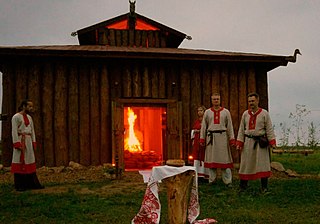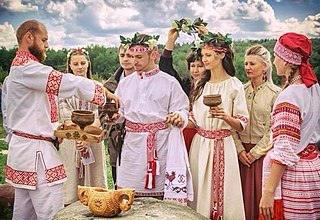| Part of a series on |
| Slavic Native Faith |
|---|
 |
The Slavic Native Faith in Ukraine has an unspecified number of adherents which ranges between the thousands and the tens of thousands.
| Part of a series on |
| Slavic Native Faith |
|---|
 |
The Slavic Native Faith in Ukraine has an unspecified number of adherents which ranges between the thousands and the tens of thousands.
Volodymyr Shaian (1908 – 1974), a linguist, philologist and Orientalist-Sanskritologist, was a pioneer of Slavic Native Faith (Rodnovery) in Ukraine during the interwar period. At an Indologist seminar in Lviv in 1937, Shaian presented his neopagan vision of a "pan-Aryan renaissance". [1]
A movement within Rodnovery which is unique to Ukraine is the Native Ukrainian National Faith, established by Lev Sylenko in the 1960s among the Ukrainian diaspora in North America, and introduced in Ukraine only in the 1990s.

In 2005, Ivakhiv noted that there were likely between 5000 and 10,000 Rodnovers in Ukraine. [2] He also observed that it had undergone dramatic growth in the country since the early and mid 1990s. [3] Other sociologists estimated that in the same years Ukrainian Rodnovers were more than 90,000 (0.2% of the total population). [4] : 1189
Ivakhiv noted that the average age of Ukrainian Rodovers was older than the average age of Pagans in the West, [2] and also noted that the religion's "main base" was "nationally oriented ethnic Ukrainians of higher-than-average educational levels". [2] He observed that there was overlap between the Rodnover communities and other sectors of Ukrainian society, such as the folk and traditional music revival groups, Cossack associations, traditional martial arts groups, and nationalist and ultra-nationalist organisations. [5] He added that Rodnovery remains "a relatively small niche in Ukrainian religious culture", [6] and that it faces a mixed reception in the country. [7] Established Ukrainian Orthodox and Roman Catholic groups have viewed Slavic Native Faith with alarm and hostility, [5] while the country's educated and intellectual classes tend to view it as a fringe part of the ultra-conservative movement which was tinged with anti-Semitism and xenophobia. [5]
In the global Ukrainian diaspora, there has been a "great decline" in the numbers practising the Native Ukrainian National Faith branch of Rodnovery. [8] This has been due to the branch's inability to attract sufficient numbers of youth in this community. [9] Alternately, the Ukrainian organisation Ancestral Fire of the Native Orthodox Faith has established groups in both Moldova and Germany. [10] In Ukraine, much like in Russia, Rodnovery is very popular among Cossacks, and the variety that they embrace, Assianism, is linked to a rediscovery of Scythian identity. Pilkington and Popov report one Russian Cossack saying that in Ukraine it is easier to meet Rodnover Cossacks than Christian Cossacks. [11]
Rodnovery has a significant role in the war in Donbas, with many Rodnovers forming or joining armed forces. Some of them—for example those of the Svarozich Battalion—have been fighting in favour of Russia; other Rodnovers—such as those of the Azov Battalion—have taken the side of Ukraine. [12] The war has stirred different reactions among Rodnovers in Ukraine; those belonging to the Native Ukrainian National Faith viewed Russia as the aggressor, while adherents of other Rodnover organisations like the Ancestral Fire of the Native Orthodox Faith more commonly saw Russians and Ukrainians as brothers and believed that the conflict was caused by the machinations of the United States. [13]
Russian Rodnover military formations in Donbas include the Svarog, Varyag and Rusich formations, and Rodnovers within the Russian Orthodox Army. Observers have highlighted that Russian Rodnovers have been proselytising in the region, with the endorsement of Russia, under the name "Orthodoxy" and preaching the concept of a new "Russian World", and that their beliefs have even permeated the Orthodox Christian church. [14]
As of 2016, the Ukrainian government granted official recognition only to four Rodnover organisations, among tens of them, and to more than thirty other congregations not affiliated with the four. The four Rodnover organisations with official registration as religious entities are the following ones: [15]
Prav (Правь), Yav (Явь) and Nav (Навь) are the three dimensions or qualities of the cosmos as described in the first chapter of the Book of Light and in the Book of Veles of Slavic Native Faith (Rodnovery). Older sources mention only Nav and Yav concepts of ancient slavic cosmology, similar to Yin and Yang in Taoism, and Prav was not part of the concept. The literal meanings of the Prav, Yav, and Nav words, are, respectively, "Right", "actuality" and "probability". They are also symbolised as a unity by the god Triglav. Already Ebbo documented that the Triglav was seen as embodying the connection and mediation between Heaven, Earth and the underworld / humanity; these three dimensions were also respectively associated to the colours white, green and black as documented by Karel Jaromír Erben.

The Slavic Native Faith, commonly known as Rodnovery and sometimes as Slavic Neopaganism, is a modern Pagan religion. Classified as a new religious movement, its practitioners hearken back to the historical belief systems of the Slavic peoples of Central and Eastern Europe, though the movement is inclusive of external influences and hosts a variety of currents. "Rodnovery" is a widely accepted self-descriptor within the community, although there are Rodnover organisations which further characterise the religion as Vedism, Orthodoxy, and Old Belief.

A volkhv or volhv is a priest in ancient Slavic religions and contemporary Slavic Native Faith.

Religion in Slovakia is predominantly Christianity, adhered to by about 68.8% of the population in 2021, a decrease from 75.5% in 2011 and 83.8% in 2001.

Peterburgian Vedism or Peterburgian Rodnovery, or more broadly Russian Vedism and Slavic Vedism, is one of the earliest branches of Rodnovery and one of the most important schools of thought within it, founded by Viktor Nikolayevich Bezverkhy in Saint Petersburg, Russia, in the 1970s. Early Peterburgian Vedism developed independently from other Rodnover movements in the inland of Russia, due to the distinguished culture of the city of Saint Petersburg itself, and represents one of the most cohesive right-wing nationalist Rodnover movements.

The Native Ukrainian National Faith, also called Sylenkoism (Силенкоїзм) or Sylenkianism (Силенкіянство), and institutionally also known as the Church of Ukrainian Native Faith or Church of the Faithful of the Native Ukrainian National Faith, is a branch of Rodnovery specifically linked to the Ukrainians that was founded in the mid 1960s by Lev Sylenko (1921–2008) among the Ukrainian diaspora in North America, and first introduced in Ukraine in 1991. Sylenkoite communities are also present in Russia and Belarus, as well as in Western Europe and Oceania. The doctrine of this tradition is codified into a sacred book composed by Sylenko himself, the Maha Vira. Sylenkoite theology is characterised by a solar monotheism.

Slavic Native Faith or Slavic Neopaganism in Russia is widespread, according to some estimates from research organisations which put the number of Russian Rodnovers in the millions. The Rodnover population generally has a high education and many of its exponents are intellectuals, many of whom are politically engaged both in the right and the left wings of the political spectrum. Particular movements that have arisen within Russian Rodnovery include various doctrinal frameworks such as Anastasianism, Authentism, Bazhovism, Ivanovism, Kandybaism, Levashovism, Peterburgian Vedism, Slavic-Hill Rodnovery, Vseyasvetnaya Gramota, the Way of Great Perfection, the Way of Troyan, and Ynglism, as well as various attempts to construct specific ethnic Rodnoveries, such as Krivich Rodnovery, Meryan Rodnovery, Viatich Rodnovery. Rodnovery in Russia is also influenced by, and in turn influences, movements that have their roots in Russian cosmism and identify themselves as belonging to the same Vedic culture, such as Roerichism and Blagovery.

Slavic Native Faith and Christianity are mutually critical and often directly hostile to each other. Among the Slavic Native Faith critiques are a view of religious monotheism as the root of mono-ideologies, by which is meant all ideologies that promote "universal and one-dimensional truths", unable to grasp the complexity of reality and therefore doomed to failure one after the other. These mono-ideologies include Abrahamic religions in general, and all the systems of thought and practice that these religions spawned throughout history, including both Marxism and capitalism, the general Western rationalistic mode of thinking begotten by the Age of Enlightenment, and ultimately the technocratic civilisation based on the idea of possession, exploitation and consumption of the environment. They are regarded as having led the world and humanity to a dead-end, and as destined to disappear and to be supplanted by the values represented by Rodnovery itself. To the "unipolar" world created by the mono-ideologies, and led by the American-influenced West, the Rodnovers oppose their political philosophy of "nativism" and "multipolarism".
Slavic Native Faith (Rodnovery) has a theology that is generally monistic, consisting in the vision of a transcendental, supreme God which begets the universe and lives immanentised as the universe itself, present in decentralised and autonomous way in all its phenomena, generated by a multiplicity of deities which are independent hypostases, facets, particles or energies of the consciousness and will of the supreme God itself.

In the Russian intellectual milieu, Slavic Native Faith (Rodnovery) presents itself as a carrier of the political philosophy of nativism/nationalism/populism (narodnichestvo), intrinsically related to the identity of the Slavs and the broader group of populations with Indo-European speaking origins, and intertwined with historiosophical ideas about the past and the future of these populations and their role in eschatology.
The Union of Slavic Communities of the Slavic Native Faith is one of the largest Russian organisations of Slavic Native Faith (Rodnovery) groups, established in 1997, and officially recognised by the government in 2014.
Slavic Native Faith in Poland has in 2007, according to Scott Simpson, between 2000 and 2500 "actively engaged and regular participants". In 2020, Konrad Kośnik and Elżbieta Hornowska estimated that Rodnovers in Poland were between 7000 and 10,000.
Volodymyr Petrovych Shaian was a Ukrainian linguist, philologist and Orientalist-Sanskritologist. He was a pioneer of Slavic Native Faith in Ukraine during the interwar period.
The Foundation for Traditional Religions is an organisation for the protection and promotion of "traditional religions" in Russia, namely Rodnovery, other modern Paganisms, and Siberian shamanisms. It was founded in 2019 by Evgeny Alekseyevich Nechkasov, leader of the Siberian Heathen community Svarte Aske. The Foundation ceased operations in March 2022, as new media laws in Russia made it impossible and unsafe for the FTR to continue operating in the country.
Slavic-Hill Rodnovery is one of the earliest branches of Rodnovery that emerged in Russia in the 1980s founded by Aleksandr Konstantinovich Belov (1957–), and one of the largest Rodnover movements in terms of number of practitioners, counted in the many tens of thousands. The movement is characterised by a military orientation, combining Rodnover worldview with the practice of a martial arts style known as "Slavic-hill wrestling". The locution "Slavic hill" refers to the kurgan, Indo-European warrior mound burials of the Pontic–Caspian steppe.
Modern paganism, also known as contemporary paganism and neopaganism, is a collective term for new religious movements which are influenced by or derived from the various historical pagan beliefs of pre-modern peoples. Although they share similarities, contemporary pagan religious movements are diverse, and as a result, they do not share a single set of beliefs, practices, or texts.

The Circle of Veles is an association of communities passionate about the development of Slavic native spirituality. Their patron is the god Veles, the Slavic god of wisdom. The supreme god is considered to be Rod, thus it is a Rodnovery (neo-pagan) association, common to Russia, Ukraine and Belarus.

Mono-ideologies are a concept in Russian political and philosophical discourse.